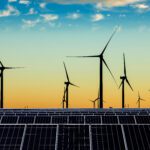Prior to the crash, the renewable energy industry—including wind, solar, geothermal, and other renewable energy sources—was on a roll. In 2007 and 2008, the U.S. wind power sector alone added over 13,500 MW of new projects, enough to power almost 4 million homes.
These projects need significant capital. New wind projects can cost $2 million per installed MW; new solar thermal projects can cost two to three times as much. Our nation’s energy policy has historically used tax benefits to incentivize renewable energy development. A typical wind project might enjoy 60 cents of tax benefit for every $1 of invested capital. But most developers can’t use all of these tax benefits and instead trade them to institutional investors in return for capital to build their projects.
Prior to the recession, there were several dozen institutions that invested in renewable energy projects to take advantage of tax benefits. By January 2009, that number had dwindled to less than five. At the same time, commercial banks, which historically provided both construction and term financing for renewable energy projects, were in an unprecedented liquidity squeeze. Overnight, debt and equity capital for renewable energy projects disappeared, posing a real threat to the continued pace of renewable energy development.
Stimulus to the Rescue
The Obama administration and Congress responded to this threat by passing the American Recovery and Reinvestment Act (ARRA) in February 2009. ARRA was intended to do many things to foster investment in renewable energy projects. Here is a scorecard for two of its key programs: the U.S. Department of Treasury cash grant program and the Department of Energy (DOE) loan guarantee program.
The Treasury Cash Grant Program—Exceeding Expectations
ARRA extended a number of tax benefits available to renewable energy technologies and for the first time permitted projects using certain technologies to elect a 30% investment tax credit. However, the availability of the investment credit will not result in more investment if there are no investors to use the credit. That is why ARRA included a novel cash grant program. In lieu of federal tax credits (and the need to find investors that can use them), project owners can receive direct grants from Treasury in an amount equal to 30% of project costs. The program was originally available only to projects that commenced construction by December 31, 2011, and are completed by a technology-specific deadline. The deadline to commence construction was just extended to December 31, 2011.
The cash grant program, by all accounts, has been the star of ARRA. Although it took several months to sort out some thorny issues, such as what “commencement of construction” means, Treasury has done a very good job in developing fairly objective program guidance. The results have been impressive. Through December 31, 2010, almost $6 billion in grants have been paid. The largest to date have included $276 million for the Meadow Lake Wind Farm in Indiana, $223 million for the Penascal Wind Farm in Texas, and $219 million for the Windy Flats Wind Farm in Washington State.
Treasury’s process for reviewing applications has run relatively smoothly, and grants have been paid quickly. If there is room for improvement, it is regarding grant eligibility. Developers that are owned by tax-exempt entities, including private equity funds with tax-exempt investors, cannot receive cash grants for their projects (even if that ownership is de minimus). Also if a tax-exempt entity buys into a project during its first five years of operation, at least a portion of the grant must be repaid. Industry has sought a “proportionate disallowance” rule, whereby instead of disqualification, the grant would be lost only to the extent of the project’s tax-exempt ownership.
The DOE Loan Guarantee Program—A Slow Start, but Improving
ARRA also introduced a new DOE loan guarantee program for renewable energy projects. This program makes available loan guarantees for up to 80% of a project’s costs. The program sunsets on September 30, 2011, and is in addition to the existing DOE loan guarantee program for “innovative” technologies.
It was difficult for the loan guarantee program to meet the high expectations many had for immediate stimulative benefit. Through 2009 and much of 2010, few guaranteed financings closed. Time was spent developing program rules and staffing up the loan guarantee program office. Frankly, many developers lost confidence that the program could move quickly enough to meet their needs.
The loan guarantee office has now tackled many of the most difficult program issues, such as collateral sharing with unguaranteed lenders. The DOE has issued loan guarantees and/or offered conditional commitments of more than $26 billion for 23 clean energy projects. All in all, the stimulus program clearly helped the pace of renewable energy development, as in 2009 and 2010 the U.S. wind industry added approximately 15,000 MW of additional capacity. Eight project financings, totaling about $4 billion, have now closed. There were $3.17 billion of financings closing in December 2010, including the guaranteed financing for the 825-MW Shepherds Flat wind project in Oregon, the largest wind project in the world. Everyone is hopeful that 2011 will prove to be another robust year for the industry.
— Adam Umanoff (aumanoff@chadbourne.com) is a partner with the Los Angeles office of Chadbourne & Parke. He specializes in the development, financings, acquisition, and sale of renewable energy projects and companies and was formerly the CEO of Enron Wind.








